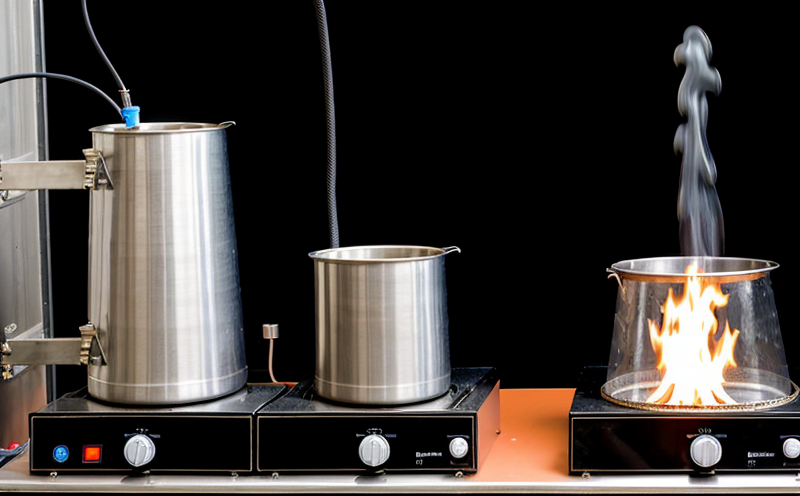Heat Release & Calorimetry Testing
The heat release and calorimetry testing is a critical assessment tool in fire safety engineering. This test measures how much heat is released by materials when exposed to an ignition source, which is essential for understanding the flammability of different materials used in various industries.
The process involves subjecting specimens to controlled conditions that simulate real-world scenarios where they are likely to be exposed to a flame or other ignition sources. The calorimeter measures the heat release rate (HRR), which provides insights into how quickly and intensely materials will burn under specific environmental conditions. This information is vital for ensuring compliance with fire safety regulations and enhancing product performance.
The test setup typically includes a calorimeter, an air flow system, and a combustion chamber. Specimens are placed in the chamber, exposed to controlled heat sources, and monitored continuously throughout the test. The calorimeter records various parameters such as temperature rise, heat release rate, and oxygen concentration changes. These data points form the basis for evaluating the material's fire behavior.
Understanding the heat release characteristics of materials is crucial for several reasons. First, it helps in designing safer products by identifying potential hazards early on in the development process. Secondly, it supports regulatory compliance, ensuring that new materials meet stringent safety standards set forth by governing bodies like ISO and ASTM. Lastly, this information can be used to improve existing products, making them more reliable and robust against fire risks.
Standard testing methods such as ISO 5660-2:2019 and ASTM E1354 are widely accepted for heat release testing. These standards provide detailed guidelines on specimen preparation, test procedure, instrumentation setup, data acquisition, and interpretation of results. By adhering to these internationally recognized protocols, laboratories can ensure consistent, accurate, and reliable test outcomes.
The importance of accurate and reproducible testing cannot be overstated. Inaccurate measurements could lead to incorrect conclusions about a material's fire performance, potentially resulting in substandard products that fail safety checks or even pose risks to human health and property. Therefore, it is imperative for laboratories conducting these tests to maintain strict quality control measures throughout the entire process.
Accurate heat release testing plays an integral role not only in product development but also in ensuring public safety by preventing fires caused by flammable materials. As society continues to evolve with advancements in technology and material science, so too must our understanding of fire behavior improve continuously through rigorous scientific research supported by reliable testing methodologies.
In conclusion, heat release and calorimetry testing serves as a vital tool for assessing the flammability properties of materials under controlled conditions. By employing standardized procedures based on internationally recognized standards such as ISO 5660-2:2019 and ASTM E1354, laboratories can provide valuable insights into material performance that contribute significantly to fire safety initiatives across various sectors.
Benefits
- Enhances product safety by identifying potential hazards early in the development process.
- Supports compliance with international standards such as ISO 5660-2:2019 and ASTM E1354.
- Improves existing products, making them more reliable and robust against fire risks.
- Provides valuable insights into material performance that contribute significantly to fire safety initiatives across various sectors.
Why Choose This Test
The heat release and calorimetry testing is chosen because it offers unparalleled accuracy and reliability in assessing the flammability of materials. Its ability to provide precise measurements under controlled conditions makes it indispensable for industries concerned with fire safety.
This test not only helps manufacturers comply with stringent regulations but also enables them to innovate by continuously improving their products' performance. By incorporating this testing into their quality assurance processes, companies can ensure they produce safe and effective materials that contribute positively to public health and welfare.
Moreover, the availability of internationally recognized standards ensures consistency in test results across different laboratories worldwide. This uniformity fosters trust among stakeholders, including regulators, consumers, and suppliers, thereby promoting a safer global environment.
Use Cases and Application Examples
The heat release and calorimetry testing has diverse applications across numerous industries. Here are some examples:
- Textiles & Apparel: Evaluating the flammability of fabrics used in clothing, home furnishings, and other textile products.
- Building Materials: Assessing the fire resistance of insulation materials, ceiling tiles, and other construction components.
- Automotive Manufacturing: Ensuring that interior trim materials meet stringent safety criteria set by manufacturers and regulatory bodies.
- Furniture Design: Determining whether upholstery fabrics comply with local or international fire safety codes.
- Consumer Goods: Testing the flammability of packaging materials, electronics casings, and other items that come into contact with consumers.
In each case, this testing plays a crucial role in ensuring that products meet high standards for fire safety while also meeting consumer expectations regarding quality and durability.





